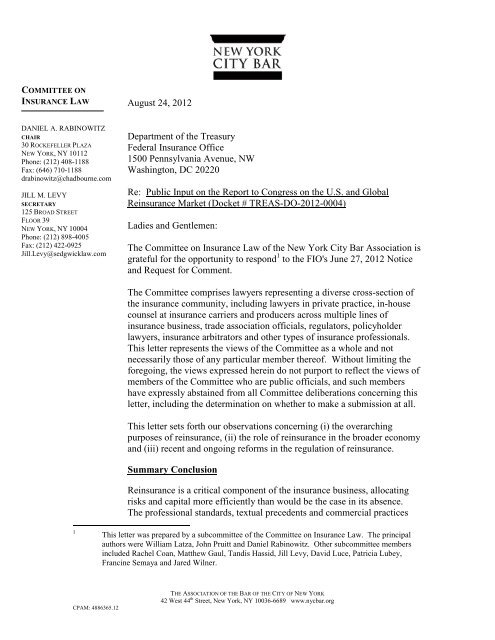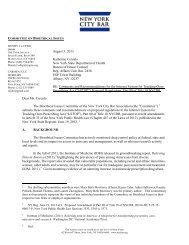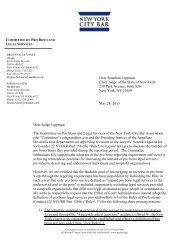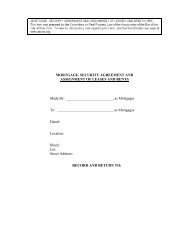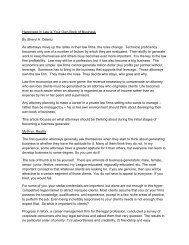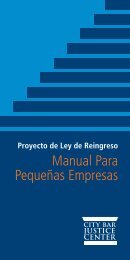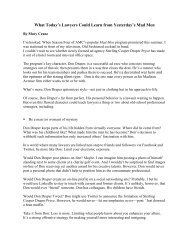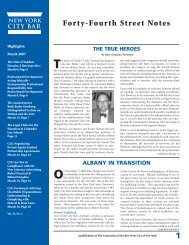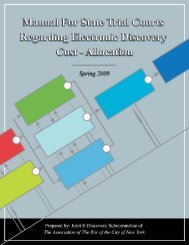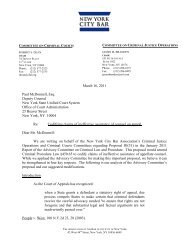Letter to the Federal Insurance Office (FIO) - New York City Bar ...
Letter to the Federal Insurance Office (FIO) - New York City Bar ...
Letter to the Federal Insurance Office (FIO) - New York City Bar ...
You also want an ePaper? Increase the reach of your titles
YUMPU automatically turns print PDFs into web optimized ePapers that Google loves.
COMMITTEE ONINSURANCE LAWAugust 24, 2012DANIEL A. RABINOWITZCHAIR30 ROCKEFELLER PLAZANEW YORK, NY 10112Phone: (212) 408-1188Fax: (646) 710-1188drabinowitz@chadbourne.comJILL M. LEVYSECRETARY125 BROAD STREETFLOOR 39NEW YORK, NY 10004Phone: (212) 898-4005Fax: (212) 422-0925Jill.Levy@sedgwicklaw.comDepartment of <strong>the</strong> Treasury<strong>Federal</strong> <strong>Insurance</strong> <strong>Office</strong>1500 Pennsylvania Avenue, NWWashing<strong>to</strong>n, DC 20220Re: Public Input on <strong>the</strong> Report <strong>to</strong> Congress on <strong>the</strong> U.S. and GlobalReinsurance Market (Docket # TREAS-DO-2012-0004)Ladies and Gentlemen:The Committee on <strong>Insurance</strong> Law of <strong>the</strong> <strong>New</strong> <strong>York</strong> <strong>City</strong> <strong>Bar</strong> Association isgrateful for <strong>the</strong> opportunity <strong>to</strong> respond 1 <strong>to</strong> <strong>the</strong> <strong>FIO</strong>'s June 27, 2012 Noticeand Request for Comment.The Committee comprises lawyers representing a diverse cross-section of<strong>the</strong> insurance community, including lawyers in private practice, in-housecounsel at insurance carriers and producers across multiple lines ofinsurance business, trade association officials, regula<strong>to</strong>rs, policyholderlawyers, insurance arbitra<strong>to</strong>rs and o<strong>the</strong>r types of insurance professionals.This letter represents <strong>the</strong> views of <strong>the</strong> Committee as a whole and notnecessarily those of any particular member <strong>the</strong>reof. Without limiting <strong>the</strong>foregoing, <strong>the</strong> views expressed herein do not purport <strong>to</strong> reflect <strong>the</strong> views ofmembers of <strong>the</strong> Committee who are public officials, and such membershave expressly abstained from all Committee deliberations concerning thisletter, including <strong>the</strong> determination on whe<strong>the</strong>r <strong>to</strong> make a submission at all.This letter sets forth our observations concerning (i) <strong>the</strong> overarchingpurposes of reinsurance, (ii) <strong>the</strong> role of reinsurance in <strong>the</strong> broader economyand (iii) recent and ongoing reforms in <strong>the</strong> regulation of reinsurance.Summary ConclusionReinsurance is a critical component of <strong>the</strong> insurance business, allocatingrisks and capital more efficiently than would be <strong>the</strong> case in its absence.The professional standards, textual precedents and commercial practices1This letter was prepared by a subcommittee of <strong>the</strong> Committee on <strong>Insurance</strong> Law. The principalauthors were William Latza, John Pruitt and Daniel Rabinowitz. O<strong>the</strong>r subcommittee membersincluded Rachel Coan, Mat<strong>the</strong>w Gaul, Tandis Hassid, Jill Levy, David Luce, Patricia Lubey,Francine Semaya and Jared Wilner.CPAM: 4886365.12THE ASSOCIATION OF THE BAR OF THE CITY OF NEW YORK42 West 44 th Street, <strong>New</strong> <strong>York</strong>, NY 10036-6689 www.nycbar.org
associated with reinsurance have developed over centuries (<strong>the</strong> earliest reinsurancearrangements and markets predate even <strong>the</strong> founding of <strong>the</strong> American colonies). Likeany financial market or product, reinsurance is imperfect and imposes risks. However,we believe that those risks are sufficiently localized <strong>to</strong> <strong>the</strong> insurance sec<strong>to</strong>r itself thatreinsurance cannot be said <strong>to</strong> cause systemic risk. Reinsurance largely promotesfinancial stability and economic activity as opposed <strong>to</strong> concentrating risks or dis<strong>to</strong>rtingmarkets. In addressing reinsurance issues from a public policy standpoint, publicofficials should carefully distinguish between reinsurance and <strong>the</strong> sec<strong>to</strong>rs of <strong>the</strong> financialmarkets that contributed <strong>to</strong> <strong>the</strong> events of 2008. By <strong>the</strong> same <strong>to</strong>ken, <strong>the</strong> success ofreinsurance does depend on thoughtful regula<strong>to</strong>ry involvement. Although generallyencouraged by recent developments in reinsurance regulation, we do urge continuedefforts <strong>to</strong> reduce regula<strong>to</strong>ry ambiguity and uncertainty and <strong>to</strong> regulate from <strong>the</strong> standpoin<strong>to</strong>f widely shared public policy priorities.Purposes and Effects of ReinsuranceReinsurance is a form of insurance, both parties <strong>to</strong> which are <strong>the</strong>mselves insurancecompanies. It is a contract of indemnity, pursuant <strong>to</strong> which one insurance company (mos<strong>to</strong>ften called <strong>the</strong> "direct insurer" or "ceding company") is insured against <strong>the</strong> liabilities ithas assumed under one or more insurance policies it has issued. The insurance companythat provides this protection <strong>to</strong> <strong>the</strong> ceding company is most often called <strong>the</strong> "reinsurer" or<strong>the</strong> "assuming company". It is "<strong>the</strong> ceding by one insurance company <strong>to</strong> ano<strong>the</strong>r of all ora portion of its risks for a stipulated portion of <strong>the</strong> premium." 2 Put ano<strong>the</strong>r way, <strong>the</strong>ceding company reduces its maximum exposure in <strong>the</strong> event of a loss by purchasing <strong>the</strong>right <strong>to</strong> reimbursement from <strong>the</strong> assuming company for all or a portion (that is, <strong>the</strong>reinsured portion) of <strong>the</strong> loss.The key characteristics of reinsurance are that it is a contract of indemnity and not onecreating a primary obligation, that it does not generate fresh premiums and that <strong>the</strong>insurable interest of <strong>the</strong> entity reinsured is its insurance liability. 3 Reinsurance differsfrom direct insurance by conferring an immediate financial benefit on <strong>the</strong> indemnifiedentity. While a homeowner, for illustration, cannot recognize <strong>the</strong> loss until his home isdestroyed, his insurer must establish current liabilities as a result of issuing a policyinsuring his home against destruction. These liabilities include an "unearned premiumreserve" representing <strong>the</strong> portion of <strong>the</strong> booked premium that corresponds <strong>to</strong> <strong>the</strong>unexpired portion of <strong>the</strong> policy term and loss reserves reflecting <strong>the</strong> amounts estimated <strong>to</strong>be necessary in order <strong>to</strong> pay losses under <strong>the</strong> policy. Subject <strong>to</strong> regula<strong>to</strong>ry requirements,reinsurance permits <strong>the</strong> insurer <strong>to</strong> record a reduction in both those current liabilities.The use of reinsurance reduces volatility of direct insurers' operating results, promotes<strong>the</strong> efficient use of capital and underwriting resources and allows for a greater number ofinsurers <strong>to</strong> participate in <strong>the</strong> market. Absent reinsurance, only <strong>the</strong> very largest insurers23CPAM: 4886365.12Skandia America Reins. Corp. v. Schenck, 441 F.Supp. 715, 724 (S.D.N.Y 1977).As insurance companies <strong>the</strong>mselves, reinsurers also cede reinsurance. That transaction is called a"retrocession" and <strong>the</strong> reinsurer that assumes <strong>the</strong> retrocession is called a "retrocessionaire". Theretrocessionaire can retrocede, and so on, diversifying exposure <strong>to</strong> loss throughout <strong>the</strong> world-widepool of insurance capital.2
that have enough capital <strong>to</strong> withstand major loss events or <strong>to</strong> finance <strong>the</strong> strain on capitalfrom writing new business could exist.Risk management. First, and most importantly, reinsurance lays off risk, <strong>the</strong>rebytransferring it <strong>to</strong> entities better able and more willing <strong>to</strong> bear it. This allows a directinsurer <strong>to</strong> calibrate its risk <strong>to</strong>lerance levels with more precision. For example, an insurermay wish <strong>to</strong> cap its losses from a particular event or exposure. In <strong>the</strong> property/casualtyarena, <strong>the</strong> covered losses could be all losses from a single catastrophic event or fromsingle peril (e.g., winds<strong>to</strong>rm or earthquake) or in a single geographic region. In <strong>the</strong> lifeinsurance arena, reinsurance may serve <strong>to</strong> cap morbidity and mortality risk, persistencyrisk (<strong>the</strong> risk associated with policyholders' allowing policies <strong>to</strong> lapse or surrendering<strong>the</strong>ir coverage) or investment risk (credit, interest rate and reinvestment). In <strong>the</strong>seexamples, reinsurance allows <strong>the</strong>se risks <strong>to</strong> be dispersed among multiple reinsurers,which may agree <strong>to</strong> be exposed <strong>to</strong> ei<strong>the</strong>r "vertical" (losses above or below certainattachments points) or "horizontal" (pro rata exposure <strong>to</strong> a single tranche of losses) slicesof <strong>the</strong> same risk.The ability <strong>to</strong> cap or reduce risk exposure is critical <strong>to</strong> insurers, because o<strong>the</strong>rwise <strong>the</strong>ywould have <strong>to</strong> hold more capital (for regula<strong>to</strong>ry, rating and risk-management reasons) asa cushion against greater-than-expected losses or losses that are expected but with lessfrequency. 4 In addition, in <strong>the</strong> absence of reinsurance, insurers might face undiversifiedrisks <strong>to</strong> specific geographic regions or perils. Reduced balance-sheet and earningsvolatility resulting from reinsurance can moderate <strong>the</strong>se effects and enable insurers <strong>to</strong>attract capital from inves<strong>to</strong>rs <strong>to</strong> support <strong>the</strong>ir underwriting activity.Increases underwriting capacity. Reinsurance increases ceding insurers' underwritingcapacity by reducing net premiums and liabilities. Most states have laws that limit aninsurer's net exposure <strong>to</strong> any single risk <strong>to</strong> 10 percent of its policyholder surplus.Regula<strong>to</strong>rs, rating agencies and market analysts closely watch individual insurers'premium volumes and <strong>to</strong>tal liabilities relative <strong>to</strong> <strong>the</strong>ir capital base <strong>to</strong> determine whe<strong>the</strong>r<strong>the</strong>y are operating with <strong>to</strong>o much leverage. Reinsurance, ceteris paribus, serves <strong>to</strong> reducean insurer's net liabilities and net written premiums for purposes of calculating applicableratios and net exposure. The principle underlying this accounting treatment is that <strong>the</strong>risk has been laid off <strong>to</strong> <strong>the</strong> reinsurer, as discussed above.For example, an insurer that cedes 50% of its premiums and losses <strong>to</strong> a reinsurer willneed <strong>to</strong> hold only half of <strong>the</strong> additional capital that it o<strong>the</strong>rwise would need <strong>to</strong> hold foreach additional policy (though <strong>the</strong> insurer may have a capital charge for cededreinsurance), and <strong>the</strong> risk will be cut by half for purposes of applying <strong>the</strong> 10% single riskrule. In <strong>the</strong> life insurance arena, "ceding commissions" paid by reinsurers helpcompensate <strong>the</strong> ceding insurer for expenses borne by it in acquiring <strong>the</strong> risks in <strong>the</strong> first4CPAM: 4886365.12Insurers are required <strong>to</strong> hold capital as a cushion in case losses under <strong>the</strong>ir policies exceed <strong>the</strong>assets <strong>the</strong>y set aside as reserves. <strong>Insurance</strong> regula<strong>to</strong>rs and rating agencies moni<strong>to</strong>r capital levelsand form judgments concerning whe<strong>the</strong>r insurers are operating with a capital cushion that isadequate in relation <strong>to</strong> <strong>the</strong> volume of <strong>the</strong>ir insurance business or <strong>the</strong> size of <strong>the</strong>ir liabilities. Theydo this by calculating premium-<strong>to</strong>-surplus and liabilities-<strong>to</strong>-surplus ratios and risk-based capitaland o<strong>the</strong>r similar ratios that <strong>the</strong>y use <strong>to</strong> moni<strong>to</strong>r insurers' activities. Commercial counterpartiessuch as lenders and o<strong>the</strong>r inves<strong>to</strong>rs will also be alert <strong>to</strong> insurers' capital adequacy.3
place, such as <strong>the</strong> costs associated with compensating insurance agents or conductingunderwriting activities. In each case, <strong>the</strong> reinsurance allows ceding companies <strong>to</strong> writelarger risks and more insurance policies than <strong>the</strong>y o<strong>the</strong>rwise could write on a limitedcapital base, while spreading <strong>the</strong> costs associated with providing insurance more broadlyacross all of <strong>the</strong>se risk-takers.The result is that <strong>the</strong> insurer closest <strong>to</strong> <strong>the</strong> cus<strong>to</strong>mer gets <strong>to</strong> maximize <strong>the</strong> use of its sales,underwriting, policy administration and claims resources, while reinsurers are able <strong>to</strong>absorb insurance risk exposures from ceding insurers and earn profits from insurancewithout having <strong>to</strong> build capabilities in <strong>the</strong>se areas. In addition, <strong>the</strong> concentration of riskof specific perils or geographic locations is diminished, allowing insurers and reinsurers<strong>to</strong> bear risks across a more diversified, broader statistical sampling of exposures.Allows sharing of risks and profits. Ano<strong>the</strong>r use of reinsurance is <strong>to</strong> facilitate <strong>the</strong>involvement by multiple entities in marketing or underwriting primary insurance.Reinsurance allows different insurers who have partnered or entered in<strong>to</strong> a joint ventureon a product line <strong>to</strong> share in <strong>the</strong> underwriting results – one as <strong>the</strong> direct policy issuingcompany, <strong>the</strong> o<strong>the</strong>r as <strong>the</strong> reinsurer. Oftentimes, smaller insurers tap in<strong>to</strong> risk models andunderwriting expertise offered by <strong>the</strong>ir reinsurers. These would be very expensive for <strong>the</strong>direct insurers <strong>to</strong> procure on <strong>the</strong>ir own, and <strong>the</strong> reinsurance allows <strong>the</strong> ceding insurer andreinsurer <strong>to</strong> participate in <strong>the</strong> underwriting results. This allows <strong>the</strong> parties' interests <strong>to</strong> bealigned and, again, allows for more efficient deployment of capital and operatingcapabilities by allowing one party <strong>to</strong> focus on cus<strong>to</strong>mer-facing activity while <strong>the</strong> o<strong>the</strong>rprovides capital support and risk management expertise.Transfers underwriting income and losses <strong>to</strong> different units within <strong>the</strong> same consolidatedgroup. Many insurers are part of a group of companies under common ownership andcontrol. Separate insurers exist within <strong>the</strong> group because <strong>the</strong>y may operate in differentjurisdictions, sell different products or use different distribution systems; <strong>the</strong>y also mayexist for purely his<strong>to</strong>rical reasons. Reinsurance allows <strong>the</strong> revenues and assets of a groupof insurers under common ownership within a consolidated group <strong>to</strong> be pooled andredistributed within <strong>the</strong> group <strong>to</strong> maximize <strong>the</strong> use of <strong>the</strong> group’s capital.Transfers blocks of insurance business. Reinsurance is also used as a vehicle by whichan insurer can sell <strong>to</strong> ano<strong>the</strong>r a line of insurance or portfolio of existing policies. Aninsurer that wishes <strong>to</strong> exit a line of insurance may do so by finding a purchaser. The saletypically will be structured so that <strong>the</strong> seller cedes <strong>the</strong> premiums and liabilities in <strong>the</strong>specified line of insurance <strong>to</strong> <strong>the</strong> purchaser. The availability of reinsurance as a <strong>to</strong>ol <strong>to</strong>transfer blocks of policies makes it possible for insurers <strong>to</strong> enter and exit lines of businessmore readily than <strong>the</strong>y could o<strong>the</strong>rwise; this, in turn, promotes <strong>the</strong> efficient deploymen<strong>to</strong>f capital and management resources.Role of Reinsurance in <strong>the</strong> Broader Commercial Sphere and Financial MarketsTransparency and market discipline. Reinsurance is not a source or carrier of systemicrisk.CPAM: 4886365.124
For one thing, as insurance companies <strong>the</strong>mselves, reinsurers are regulated by <strong>the</strong>irdomiciliary insurance regula<strong>to</strong>rs. For reinsurers domiciled in <strong>the</strong> United States, thismeans that <strong>the</strong>ir financial condition and operations are subject <strong>to</strong> detailed rules andcareful scrutiny by actuaries, audi<strong>to</strong>rs and state examiners. Regulation includes financialsolvency rules and oversight in such areas as reserves, investments and capital adequacy,along with corporate governance and transactions with affiliates. Uniform financialreporting and a comprehensive basis of accounting yield financial statements that areconsistent and comparable period-<strong>to</strong>-period and company-<strong>to</strong>-company.As ano<strong>the</strong>r example, insurance laws in <strong>the</strong> U.S. have his<strong>to</strong>rically restricted <strong>the</strong> ability ofcedents <strong>to</strong> record ceded reinsurance as a financial asset ("credit for reinsurance") where<strong>the</strong> reinsurer is based outside <strong>the</strong> U.S. and not licensed anywhere in <strong>the</strong> U.S. The premiseof <strong>the</strong>se laws has been that cedents should not be allowed <strong>to</strong> claim <strong>the</strong> financial benefitsassociated with reinsurance (e.g., an increase <strong>to</strong> surplus or a reduction in liabilities) where<strong>the</strong> reinsurance has been ceded <strong>to</strong> carriers that are not subject <strong>to</strong> oversight by U.S.regula<strong>to</strong>rs. In such cases, as a precondition <strong>to</strong> claiming reinsurance as an asset, <strong>the</strong>selaws and regulations impose obligations on <strong>the</strong> reinsurer <strong>to</strong> secure its obligations under<strong>the</strong> reinsurance contract by posting collateral in favor of <strong>the</strong> ceding company. Asdiscussed infra, recent and ongoing reforms in <strong>the</strong>se laws will have <strong>the</strong> effect ofpermitting credit even where <strong>the</strong> reinsurer is non-U.S. based, as long as such reinsurer isdeemed sufficiently creditworthy and its home jurisdiction sufficiently rigorous inregulating insurance.Collateral requirements are also a common commercial requirement imposed by <strong>the</strong>market itself. In o<strong>the</strong>r words, cedents may exercise leverage over reinsurers in <strong>the</strong>marketplace by insisting on security with respect <strong>to</strong> particular risks; reinsurers are thusforced <strong>to</strong> compete with one ano<strong>the</strong>r on this basis. These restrictions, both regula<strong>to</strong>ry andmarket-imposed, effectively mitigate both insurers' misuse of reinsurance <strong>to</strong> manipulateor obscure <strong>the</strong>ir own financial condition and <strong>the</strong>ir risk of exposure <strong>to</strong> <strong>the</strong> insolvency ofany single reinsurer.Inter-connectedness within and without <strong>the</strong> insurance sec<strong>to</strong>r. In its Final Rule andInterpretive Guidance concerning Authority To Require Supervision and Regulation ofCertain Nonbank Financial Companies, issued in April 2012, <strong>the</strong> Financial StabilityOversight Council deemed "connectivity" <strong>to</strong> be an important determinant of systemicrisk. 5 Last month, however, <strong>the</strong> International Association of <strong>Insurance</strong> Supervisorspublished its report Reinsurance and Financial Stability, 6 in which it concluded,Business relationships between cedents and reinsurers establish directlinks which are frequently deepened by <strong>the</strong> extension of risk and capitalmanagement services offered by reinsurers. This intra-sec<strong>to</strong>r connectivityis unlikely <strong>to</strong> transcend <strong>the</strong> boundaries of <strong>the</strong> insurance market and spillover in<strong>to</strong> <strong>the</strong> broader financial market as long as business relationships are56CPAM: 4886365.1277 FR 21637 (Apr. 11, 2012) . https://www.federalregister.gov/articles/2012/04/11/2012-8627/authority-<strong>to</strong>-require-supervision-and-regulation-of-certain-nonbank-financial-companies#h-15http://www.iaisweb.org/O<strong>the</strong>r-papers-and-reports-46.5
CPAM: 4886365.12confined <strong>to</strong> traditional reinsurance activities. . . . traditional reinsurance isunlikely <strong>to</strong> cause, or amplify, systemic risk . . . . 7We concur with this assessment. One reason that reinsurance differs in this regard fromo<strong>the</strong>r forms of secondary transfers of financial risks (e.g., derivatives, securitization, bankparticipations) is that it is more common for a major reinsurer <strong>to</strong> focus principally onreinsurance. By contrast, financial risks in o<strong>the</strong>r sec<strong>to</strong>rs are more likely <strong>to</strong> be transferredamong similar kinds of firms, with less specialization among <strong>the</strong>m as <strong>to</strong> primary orsecondary versions of <strong>the</strong>se exposures. As a result, direct writers of insurance arerelatively less exposed <strong>to</strong> <strong>the</strong> insurance risks of peer carriers, and large reinsurers tend <strong>to</strong>be specialized in <strong>the</strong>se risks as a matter of expertise. While certain non-insuranceactivities of reinsurers (such as writing derivatives or engaging in "syn<strong>the</strong>tic" reinsurancethrough <strong>the</strong> use of securitization techniques) can expose those reinsurers and <strong>the</strong> broadermarket <strong>to</strong> financial risk, <strong>the</strong>se activities his<strong>to</strong>rically have not been central <strong>to</strong> reinsurers'business. Reinsurers are, and should continue <strong>to</strong> be, subject <strong>to</strong> appropriate regulation in<strong>the</strong>se areas as are o<strong>the</strong>r participants in those markets. However, <strong>the</strong>se activities per se donot warrant additional regulation of reinsurers as such. Reinsurance has predominantlybeen insular <strong>to</strong> <strong>the</strong> insurance community ra<strong>the</strong>r than "inter-connected" with o<strong>the</strong>r sec<strong>to</strong>rsin <strong>the</strong> sense associated with <strong>the</strong> 2008 financial crisis.Availability of substitutes <strong>to</strong> traditional reinsurance. Lack of substitutability is alsobelieved <strong>to</strong> be an important fac<strong>to</strong>r contributing <strong>to</strong> systemic risk. 8 The reinsurance marketis characterized by comparatively low barriers <strong>to</strong> entry. For example, each time aninsured catastrophe has caused significant erosion of capital in <strong>the</strong> insurance sec<strong>to</strong>rduring <strong>the</strong> past two decades (most notably, 1992's Hurricane Andrew, <strong>the</strong> terrorist attacksof September 11, 2001 and <strong>the</strong> Gulf of Mexico hurricanes of <strong>the</strong> mid-2000s), newreinsurers have been born in <strong>the</strong> marketplace <strong>to</strong> take advantage of attractive reinsurancepricing that typically is expected <strong>to</strong> follow major catastrophes. This demonstrates thatcapital flows relatively easily in<strong>to</strong> <strong>the</strong> supply of reinsurance as demand warrants.Moreover, <strong>the</strong> same two decades have seen <strong>the</strong> development of capital marketalternatives <strong>to</strong> traditional reinsurance, with <strong>the</strong> advent of insurance-linked securities suchas catastrophe bonds, mortality bonds, closed block notes and o<strong>the</strong>rs. There is noinherent lack of supply of, or substitutes for, reinsurance.The policy challenge is <strong>to</strong> preserve, or even enhance, substitutability, while at <strong>the</strong> sametime not exacerbating intra-sec<strong>to</strong>r risk or creating cross-sec<strong>to</strong>r risk. Scholars J. DavidCummins and Mary A. Weiss identified credit risk exposure <strong>to</strong> reinsurance counterpartiesas an important risk of inter-connectedness within <strong>the</strong> insurance sec<strong>to</strong>r. While requiringfull collateralization of reinsurance recoverables could mitigate that risk, it also couldraise a barrier <strong>to</strong> <strong>the</strong> entry of fresh capital following a catastrophe.In addition, certain reforms in <strong>the</strong> regulation of o<strong>the</strong>r financial products could poseunintended consequences for this substitutability if applied <strong>to</strong> reinsurance. For example,<strong>the</strong> Dodd–Frank Wall Street Reform and Consumer Protection Act ("Dodd-Frank") 9789Id. at 5.J. David Cummins and Mary A. Weiss, Systemic Risk and <strong>the</strong> U.S. <strong>Insurance</strong> Sec<strong>to</strong>r,http://www.fic.whar<strong>to</strong>n.upenn.edu/fic/papers/11/11-07.pdf .P.L. 111-203.6
imposed various new requirements on securitization markets, including conflict-ofinterestrules. Were reinsurance <strong>to</strong> be regulated using <strong>the</strong> same approach, some of thisease of substitution for reinsurance might be vitiated. As an example, Section 621 ofDodd-Frank streng<strong>the</strong>ns conflict-of-interest restrictions in asset-backed securities. Ananalogous approach in reinsurance might restrict <strong>the</strong> use of catastrophe bonds insofar assponsoring insurers are inherently "interested" in such bonds not paying all <strong>the</strong>ir interestand principal (which would result in one or more payments <strong>to</strong> <strong>the</strong> insurer in respect of <strong>the</strong>specified insurable event). Such a result would frustrate <strong>the</strong> objective of allocating risksefficiently, including <strong>to</strong> <strong>the</strong> capital markets.Principles of RegulationAs a general matter, regulation of reinsurance in <strong>the</strong> U.S. has his<strong>to</strong>rically beencharacterized by <strong>the</strong> following principal elements: Regulation of reinsurance, like that of insurance, has been a state, not <strong>Federal</strong>,activity. Although a type of insurance, a reinsurance contract per se is not sufficient <strong>to</strong>trigger a requirement that <strong>the</strong> issuer be licensed in <strong>the</strong> state where written. Toillustrate, an insurer that writes an au<strong>to</strong> policy <strong>to</strong> a California driver must belicensed by <strong>the</strong> California insurance regula<strong>to</strong>r. By contrast, if a second insurerindemnifies <strong>the</strong> risk on that same policy by means of reinsurance, such insurerneed not be so licensed. (Its licensed or unlicensed status, however, may bear onwhe<strong>the</strong>r <strong>the</strong> primary insurer can record <strong>the</strong> reinsurance as an asset, or under whatcircumstances.) A U.S.-based reinsurer, even if not licensed in <strong>the</strong> particular state where <strong>the</strong>ceding company is domiciled, can write reinsurance without posting collateral,with <strong>the</strong> ceding company still recording credit for <strong>the</strong> reinsurance coverage. Bycontrast, a non-U.S. reinsurer is typically required <strong>to</strong> post collateral. Reinsurance intermediaries (such as reinsurance brokers) must be licensed, but<strong>the</strong> emphasis on market conduct regulation is not as acute as with primaryinsurance because <strong>the</strong> consumers of reinsurance are <strong>the</strong>mselves insurancecompanies, not "retail" purchasers of insurance.In recent years, some of <strong>the</strong> dynamics described above have shifted. The Nonadmitted and Reinsurance Reform Act ("NRRA", enacted as Subtitle Bof Title V of Dodd-Frank) limits credit-for-reinsurance jurisdiction <strong>to</strong> <strong>the</strong>domiciliary state, 10 but more generally contemplates a new uniformity andreciprocity in <strong>the</strong> way U.S. regula<strong>to</strong>rs treat non-U.S. reinsurers. In fur<strong>the</strong>rance of this approach <strong>the</strong> NRRA empowers <strong>the</strong> <strong>FIO</strong> <strong>to</strong> invalidate statelaws <strong>to</strong> <strong>the</strong> extent <strong>the</strong>y treat non-U.S. insurers or reinsurers less favorably than anadmitted insurer in that state, where <strong>the</strong> non-U.S. company is subject <strong>to</strong> a"covered agreement" (i.e., an agreement between U.S. and <strong>the</strong> non-U.S. domicileproviding for reciprocity in prudential regulation). 11 Similarly, new model credit-for-reinsurance requirements from <strong>the</strong> NationalAssociation of <strong>Insurance</strong> Commissioners ("NAIC") depart from <strong>the</strong> blanket rule1011CPAM: 4886365.12Dodd-Frank §531(a).Id., §502.7
that non-U.S. reinsurers must post collateral. The new model requirements vestdiscretion in <strong>the</strong> state regula<strong>to</strong>r <strong>to</strong> relax (or waive al<strong>to</strong>ge<strong>the</strong>r) <strong>the</strong> collateralrequirement depending on <strong>the</strong> financial strength, including <strong>the</strong> credit rating, of <strong>the</strong>reinsurer. 12The new NAIC requirements have been adopted in some states, with more likely<strong>to</strong> follow, while some large states such as <strong>New</strong> <strong>York</strong> 13 and Florida 14 haveindependently adopted <strong>the</strong>ir own credit-for-reinsurance reforms.These shifting regula<strong>to</strong>ry dynamics are encouraging insofar as <strong>the</strong>y streamline andsimplify regulation by eliminating some of <strong>the</strong> extra-terri<strong>to</strong>riality associated with a statebasedsystem (that is, reducing <strong>the</strong> exposure of a single ceding company <strong>to</strong> multiplestates' requirements), yet challenges remain. The "covered agreements" contemplated byDodd-Frank will need <strong>to</strong> be implemented, and <strong>the</strong> <strong>Federal</strong> government's relatedpreemption power will need <strong>to</strong> be exercised, in a way that does not disrupt <strong>the</strong> smoothfunctioning of <strong>the</strong> reinsurance markets by limiting <strong>the</strong> availability of reinsurance for anyof <strong>the</strong> purposes we have outlined in this letter, by creating unnatural advantages ordisadvantages for particular market segments or by overturning settled rules and practicesin <strong>the</strong> state regula<strong>to</strong>ry framework without clear and fully considered replacements. Inaddition, <strong>the</strong> provisions of Dodd-Frank that vest in <strong>the</strong> domiciliary state <strong>the</strong> exclusivepower <strong>to</strong> regulate <strong>the</strong> solvency of "reinsurers" (defined in broad and subjective terms) 15represent a departure from long-standing principles of state law and raise a number ofpotential ambiguities. As regula<strong>to</strong>rs and policymakers, including <strong>the</strong> <strong>FIO</strong>, examine <strong>the</strong>seand related issues, we would encourage <strong>the</strong>m <strong>to</strong> act with due regard for <strong>the</strong> characteristicsof reinsurance that bring efficiency and capacity <strong>to</strong> <strong>the</strong> insurance marketplace with aminimum of risk <strong>to</strong> ei<strong>the</strong>r consumers of insurance or <strong>the</strong> broader economy.* * * * *Our Committee would be pleased <strong>to</strong> respond <strong>to</strong> any questions on <strong>the</strong> foregoing. TheCommittee also welcomes <strong>the</strong> opportunity <strong>to</strong> assist <strong>the</strong> <strong>FIO</strong> both in connection withDirec<strong>to</strong>r McRaith's forthcoming report <strong>to</strong> Congress on reinsurance and, more generally,in advancing <strong>the</strong> <strong>FIO</strong>'s important work.Respectfully submitted,Daniel A. RabinowitzChair, Committee on <strong>Insurance</strong> Law12131415CPAM: 4886365.12NAIC Credit for Reinsurance Model Law, §2(E); NAIC Credit for Reinsurance Model Regulation,§8(A)(1).NY <strong>Insurance</strong> Dept. Regs. 17, 20 and 20-A, eff. Jan. 1, 2011.Fla. Admin. Code §69O-144.007.Dodd-Frank §§532-33.8


